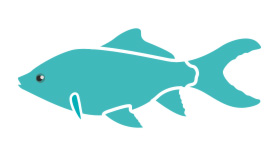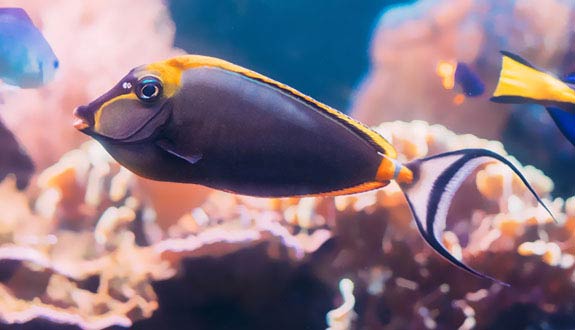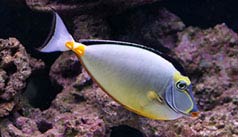

Alternative species (click on the thumbnail to see the card)
Names
Scientific name
Naso lituratus
Aspisurus carolinarum
Callicanthus lituratus
Monoceros garretti
Naso literatus
Prionurus eoume
Common name
Naso tang
Orangespine unicornfish
Barcheek unicornfish
Nashornfisch (DE)
Origin

Origin: Indian Ocean, South Pacific and Red Sea
Natural habitat: it evolves in the coral reefs and the landslides of the lagoons, up to 30m (98 feet) deep
Dimorphism

The males have filaments on the caudal which the females do not have.
Group

Acanthuridae
Volume

1,000 L / 220 imp gal / 265 US gal
Parameters

T°: 24 to 28°C or 75 to 82°F
pH: 7.8 to 8.5
Density: 1021 to 1026
Difficulty

Easy
Size

30 cm (12")
Longevity

15 to 20 years
Living zone

Middle and depth
Individuals

1
Food
How to feed the Naso tang?
Food
How to feed the Naso tang?
This mainly herbivorous fish requires an essentially vegetable food. Offer it salad, spinach, broccoli... Algae such as Caulerpes for example must also be distributed or made available in the aquarium.
Make also small contributions of meat food with small preys such as artemia or krill for example.
Behavior
What kind of behavior does the Naso tang have?
Behavior
What kind of behavior does the Naso tang have?
Fish with a rather massive aspect is nevertheless a good swimmer, even if its swimming can appear nonchalant! Because of this, it needs quite a lot of space to evolve freely.
It is rather curious and will not hesitate to come and see you more closely when it comes up under the surface.
Cohabitation
Who can live with the Naso tang?
Cohabitation
Who can live with the Naso tang?
This Surgeon has a rather good character and he is much less aggressive than the Acanthurs. He is generally peaceful and sociable. Therefore, be careful that he does not suffer from too strong domination from other character species, which could harm his quality of life.
In addition, maintenance with another member of its species is not possible because it is a fighter with them (note that a period of tolerance may seem to set in, to give way to disputes and fights from one day to the next).
He appreciates the presence of calm fish, but too small because there is a risk of predation by the unicornfish on small fish.
Breeding
How to breed the Naso tang?
Breeding
How to breed the Naso tang?
Impossible in captivity.
Juveniles are very different from their parents: they are grey/blue with small white spots.
Its aquarium
Which aquarium for the Naso tang?
Its aquarium
Which aquarium for the Naso tang?
This fish can be kept in a reef aquarium composed of rocks, invertebrates and a lot of algae such as Sargasso, Dictyota or Caulerpes (they will nevertheless be used as a meal, but essential for the well-being of your fish).
Install a powerful filtration system to create a strong enough current.
Cover your aquarium well because the Nasic is able to jump out of the water.
Good To know
Find all additional information!
Good To know
Find all additional information!
You are a beginner in marine aquarium keeping and you have a nice volume? The unicornfish is made for you! It is original, easy to acclimatize, to maintain and to feed, it is also robust and interesting to observe.
Acclimatization advice: Emotional at the time of its arrival, install it in a quiet place and distribute the food peacefully. For more chance of success, finely cut the plants, and bet on live artemia. The goal is to get the fish back to eating as quickly as possible because a prolonged fast can be fatal. Young fish seem easier to acclimatize than adults.
This species has a tendency to make white spots, but this can be easily avoided with good aquarium maintenance.
It is perfectly able to recognize its keeper, a charming asset for a fish!
In the wild, this fish can measure up to 50 cm (20")! However, in our aquariums, it rarely exceeds 30 cm (12")
.It does not have erectile scalpels, but 2 scaly spines on each side of its tail fin.
Beware of confusion with the Naso elegans whose dorsal fin is yellow (black in our Naso lituratus). Note that the separation of two species is quite recent (2001).
Yours photos!
Comments
Sort by:
Please login to post comments


